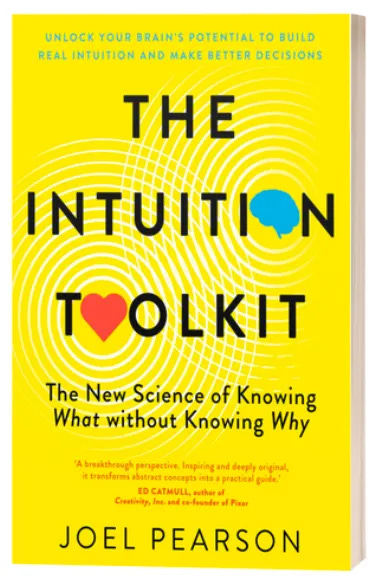The Science Behind Manifesting: is it real?
Curated, Science-Driven Insights into the Brain.
Future Minds newsletter breaks down the science of the mind and brain into short and easy-to-digest insights and actionable take-homes. Sign up and join the many others who receive it directly in their inbox.
Hello, dear readers!
I’ve been bouncing around in the US over the past week, from Palo Alto to LA and Florida - it’s been great to meet some wonderful new people and catch up with some old friends, doing some podcasts and conferencing.
In other news, my book The Intuition Toolkit is now available in the US! If you live in the US and haven’t been able to get a copy yet, here is the link:
Also, I’ve been meaning to ask you all a huge favour, it would mean the world to me if you like the book, to leave a positive review :) It will help the algorithm fairies make sure other people find the book and spread the word about the science of intuition.
This newsletter is about manifestation, something you might first cringe at a little when you read the word and think there’s no science behind it, but there actually is, read on to hear what types of manifestation are backed by science and which aren’t.
The Science Behind Manifestation
Now, before you dismiss manifestation as woo-woo alternative and wacky, hear me out. The logic behind some versions of manifestation is grounded in solid scientific principles. I'm not talking about the kind of manifestation where you simply wish for a Ferrari to appear in your driveway or a new lover and one knocks on your door out of the blue. That's not a useful way to think about manifestation – there’s no magic here.
Instead, let's delve into neuroscience and psychology. Hundreds, if not thousands, of papers have been published on attention and how our attentional systems work. These systems function like a spotlight, not only focusing our consciousness on particular items in the world around us, but also highlighting and underlining the things we are actively searching for.
Imagine flipping through a "Where's Waldo? (Wally)" book. Your brain holds the template of the little guy with the striped shirt in your working memory, and some of us even visualise it as a mental image. As you scan the complex busy page, your brain searches for anything that matches that template, like the distinctive stripes on Waldo's shirt. You’ve probably noticed that anything with similar stripes grabs your attention. This same process can work as part of manifestation.
Unlocking the Power of Manifestation - The Reticular Activating System
Have you ever wondered why some people seem to effortlessly achieve their goals, as if the universe conspires in their favour? The answer may lie in a little-known set of neural structures nestled deep within the brain: the reticular activating system. This complex network of neurons and connective tissue plays a crucial role in regulating sleep-wake cycles, attention, and, surprisingly, the manifestation of our dreams into reality.
The Power of Selective Attention
This simple process of holding a template in mind and searching for it everywhere we go extends beyond merely looking for something specific. A common example I often mention is the experience of shopping for a new car. Let's say you're considering purchasing a Tesla. After researching the different models, shapes, and colours, have you noticed that Teslas suddenly seem to jump out at you whenever you're driving? It feels like they're everywhere. This is the same attentional system at work. Without consciously putting in continuous effort to search for Teslas, your brain is still somewhat on the lookout for them, and every time your visual system spots one, it grabs your attention. This of course works for any car you might be interested in.
Another way to think about this phenomenon is the classic cocktail party effect. Imagine you're at a bustling, noisy cocktail party, deep in conversation with someone. Suddenly, you hear someone mention your name from across the room. What's happening here? You weren't consciously monitoring the conversation across the room, but as soon as your name was uttered, it jumped out at you and became the focus of your conscious awareness. Your brain is unconsciously processing all the complex and noisy data streams in the room, and as soon as your name is mentioned, it hits a red flag, grabs your attention, and pulls that information into consciousness.
Manifesting Your Goals
Now, let's apply this concept to setting goals and manifesting something you desire. By putting a lot of effort into focusing on something you want and priming yourself repeatedly throughout the day, your brain will be on the lookout for things related to that goal. This is where the reticular activating system comes into play.
The reticular activating system is a complex network of neurons nestled in the brainstem, acting as the silent observer of our consciousness. It holds the key to unlocking the secrets of manifestation and achieving our goals.
As the brain's vigilance monitor, the reticular activating system constantly scans the vast array of sensory information bombarding our senses. It filters out irrelevant stimuli and highlights what matters, like a spotlight illuminating the path to our desires. By tapping into the power of the reticular activating system, we can train our minds to recognise and seize opportunities that align with our goals.
Through repeated focus on our aspirations and objectives, we condition the reticular activating system to prioritise thoughts and experiences that align with our aims. This, in turn, makes it more likely that we will notice something important and relevant, rather than letting it drift by unnoticed.
This selective attention heightens our awareness of resources and opportunities that can propel us toward our goals. Harnessing the potential of the reticular activating system is an essential part of the manifestation process, as it helps us see the world differently.
Priming: Changing How You See the World
You may have heard of the concept of priming, mentioned above—the idea that things you come across, experience, see, or hear prime you to think, behave, or perceive things in a particular way. A classic example is if we are talking about money and finances, and I ask how much money you have? How much money you earn?
What comes to mind when you read the word "bank"? Did you interpret it to mean a financial institution and not a riverbank? In other words, talking about finances and money primes your brain semantically to interpret an ambiguous word like "bank" to mean a money bank and not a riverbank.
There is a wealth of research on priming, from semantic priming like the example I just gave, to high-level cognitive priming and even perceptual priming. In fact, we often use a type of priming in the lab to assess and measure the strength of visual imagery. As mentioned in prior newsletters, we use a visual illusion called binocular rivalry to test the perceptual strength of visual mental imagery. The way we do this is by asking someone to imagine one of two patterns and then flash this binocular rivalry visual illusion on a screen in front of them. What someone imagines biases or primes how they consciously interpret or perceive the binocular rivalry illusion.
This idea of priming is also relevant to the concept of manifestation, as it closely aligns with the notion of paying attention to certain things in the environment. If you prime yourself every morning or every couple of hours to think about certain concepts or to see certain things, it will inevitably change how you experience the world across different levels of brain processing. From potentially literally changing how you perceive the world to altering how you interpret ambiguous semantic and cognitive concepts like a bank, priming yourself can be a powerful way to change how you see the world and the things you notice. This, like attention, can lead to noticing many more opportunities and, indeed, taking advantage of them to achieve your goals.
The reticular activating system and the power of priming offer a fascinating glimpse into the inner workings of our brains and how we can harness their potential to manifest our goals and dreams. By understanding the science behind attention, selective focus, and the impact of priming on our perception, we can train our minds to recognise and seize opportunities that align with our aspirations.
So, the next time you set a goal or envision something you want to manifest in your life, remember the silent observer within your brain—the reticular activating system. Focus your attention, prime your mind, and watch as the world around you begins to transform, guiding you toward the realisation of your deepest desires.
All the best for today,
Joel
Mental Meanderings
Have you ever tried manifesting something?
Have you ever noticed priming in your day-to-day life?
What do you think of manifesting? Something full of BS or something potentially exciting to try?










Manifestation. Yes I do it daily for car parking spots and it seems to work. But I’m reluctant to do it for material goods unless I really NEED something, rather than just desire it. I also do it for healing.
Priming. Yes, I/we experience that every day online. Repetitious ads and constantly repeated ‘info.’
We are all well primed these days to keep buying more and more stuff. And to only think in a certain media or politically curated way. Very interesting to learn this happens because of our clever little reticular activating system. Hmm…. Roseann
Hi Joel, I wonder if this is the same way Confirmation Bias works in the brain? e.g., does our brain repeatedly confirm a belief (even if it’s misguided) because it is under a similar process of ‘focus of attention’, priming and, therefore, ‘manifestation’?